Indiana University School of Nursing (IUSON) opened its doors in 1914 as the Indiana University Training School for Nurses. Its mission was to fill the need for nurses in the newly opened Robert W. Long Hospital on the (IUSM) Indianapolis campus. At the time, nursing schools throughout the U.S. primarily resided within major hospitals. In Indianapolis, , , Protestant Deaconess Hospital, and already operated training schools for nurses.
The IU Training School for Nurses was the first nursing school affiliated with a university in Indiana and one of the earliest in the U.S. These included Yale University, Case Western University, and the University of Chicago. Although there were exceptions, even schools established in the university setting, like IU’s, typically continued to prepare nurses more as hospital student apprentices rather than as true university students in the first few decades of the 20th century. The Indiana University Training School for Nurses worked to advance the profession from the outset. It, however, did not officially become known as the Indiana University School of Nursing until 1956 and was not recognized as a full-fledged IU school until 1962.
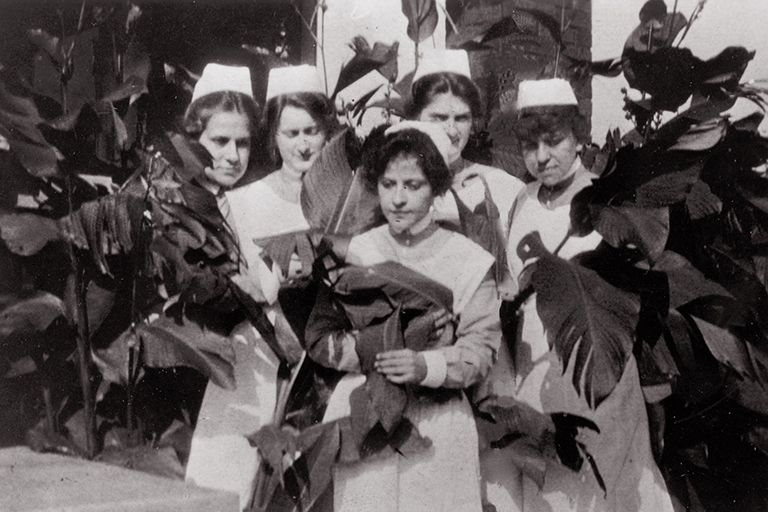
Early Years, 1914-1940
Alice Fitzgerald was the first director of the IU Training School for Nurses, serving from 1914 to 1915. She left after a short first year to assist in Europe during . The school’s first class, which graduated in 1917, consisted of five women. Some of the newly graduated nurses participated in the United States Army Nurse Corps or with the American Red Cross during World War I. Ethel P. Clarke was named the second director of the school and served from 1915 to 1931.

The 1920s was a decade of growth for the school and the IUSM Indianapolis campus. In 1922, six nursing students founded the International Honor Society of Nursing, or Sigma, as it is known today. Established to advance the status of nursing as a profession, recognize scholarship, represent the best in nursing, encourage future leaders, and provide a social forum, Sigma Theta Tau was the first nursing honor society established in the U.S. Within seven short years, it had six Midwest chapters and hosted its first national convention.
During these early years, finding adequate housing for nursing students proved difficult, especially when the opened in 1924 on the IUSM campus and William H. Coleman Hospital followed in 1927. As part of the original fundraising campaign for Riley Hospital, Ball Corporation of Muncie industrialists Frank C. and George A. Ball pledged $500,000, which was used to build the Ball Residence for Nurses. Completed in 1928, the building originally provided housing, classrooms, and laboratories for IU’s nursing students.

The Ball Nurses’ Sunken Garden was created adjacent to the Ball Residence in the early 1930s. Percival Gallagher, a principal landscape architect for the prestigious Olmsted Brothers firm (responsible for the plan of New York City’s Central Park), designed the garden. The therapeutic greenspace, featuring a central sculpture that nursing students nicknamed “Flo” (short for Florence Nightingale), was one of the first of its kind, and it remains among the largest. Significant as the only extant example of an Olmsted Brothers landscape designed for therapeutic and healing purposes, the Ball Nurses’ Sunken Garden was listed on the National Register of Historic Places in 1996.
By 1931, 168 young student nurses and 47 of the school’s graduates staffed the hospitals of the IUSM campus. During the Great Depression, student nurses worked 55-hour weeks on top of their academic work and other responsibilities.
Recognizing the need for qualified nursing instructors led IU to offer nursing education courses through its school of education in Bloomington starting in 1932. In 1933, the nursing school in Indianapolis hosted its first capping ceremony for student nurses. Presentation of the cap, recognizing completion of the first six months of the nursing program, signified students’ official initiation into the nursing profession.
World War II and the early-1950s

In 1941, the IU Training School for Nurses appeared on the National League for Nursing Education’s first list of accredited schools. By this time, more than 1,300 women had graduated from the school.
During , 107 alumnae of the school served in the United States Army, Navy, and Air Corps. The U.S. Congress passed the Nurse Training Act, also known as the Bolton Act, in 1943 to prepare large numbers of nurses for the war effort, and IU added to this effort by establishing an accelerated nursing program to allay nursing shortages.
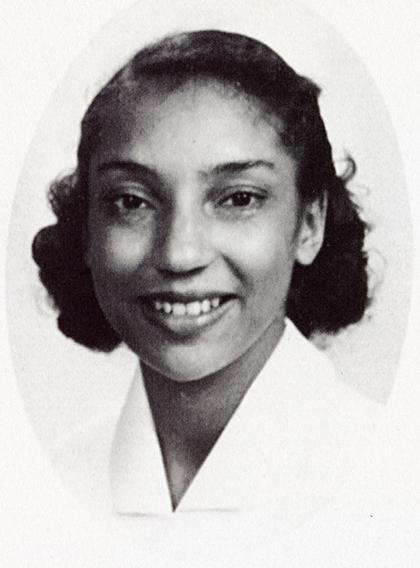
By the 1950s, the school offered three options to become a nurse, and students could choose between three-, four- and five-year tracks in the bachelor’s degree program. The school also grew to include a more diverse faculty and student population. In 1953, Ann Mitchem-Davis became the first Black student to graduate from the IU Training School for Nurses. She eventually became the assistant dean of Howard University’s College of Nursing. In 1955, Lee Fuller, PhD, RN, became the school’s first male faculty member. He was hired as a psychiatric nursing professor.
The School Comes of Age, 1956-1990
In 1956, with its degree programs in place, the IU Training School for Nurses was officially renamed the Indiana University School of Nursing. With a subsequent evaluation of its curriculum, practices, and administration, Emily Holmquist became the school’s first dean in 1957. In 1961, the National League of Nursing accredited the four-year baccalaureate degree, and, in 1962, IU formally recognized IUSON as the 10th school in the university.
Holmquist served as dean through 1973. During her tenure, the Division of Nursing Education, which had been housed in the IU School of Education, was united with IUSON and located in Indianapolis. Between 1965 and 1969, IUSON implemented an associate of science in nursing (ASN) degree program across the Indiana University campuses. The school also began admitting its first male students in the 1960s. The decade saw 10 male graduates, including John Foster, the first male to be awarded a bachelor of science in nursing (BSN) in 1967.
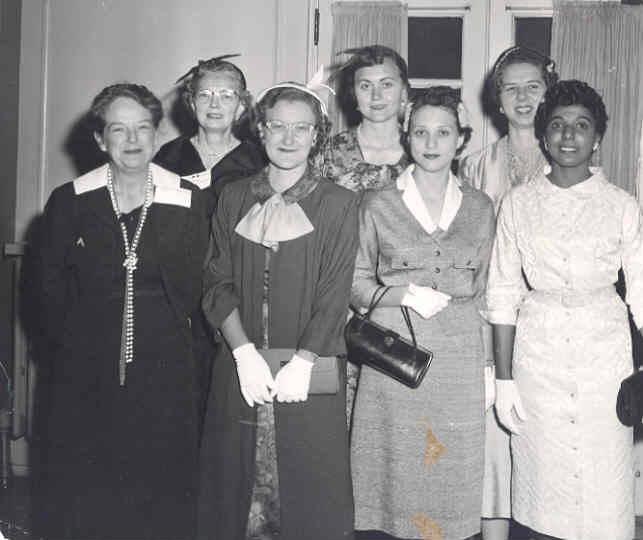
With the dawn of the 1970s came a new period of growth for the IU School of Nursing. In 1970, construction began on a new $7 million building on the campus. The nursing building was dedicated in May 1974.
Under the leadership of Dean Elizabeth Grossman (1973-1988), diversity integration became a priority. Dean Grossman convened the IU School of Nursing Black Faculty Committee to address minority student and faculty concerns. In 1971, Lauranne Sams became the first Black faculty member and a founding member of the National Black Nurses Association (NBNA). Laurie Gunter was named the IUSON’s first Black administrator, after joining the faculty in 1965 as director of research.
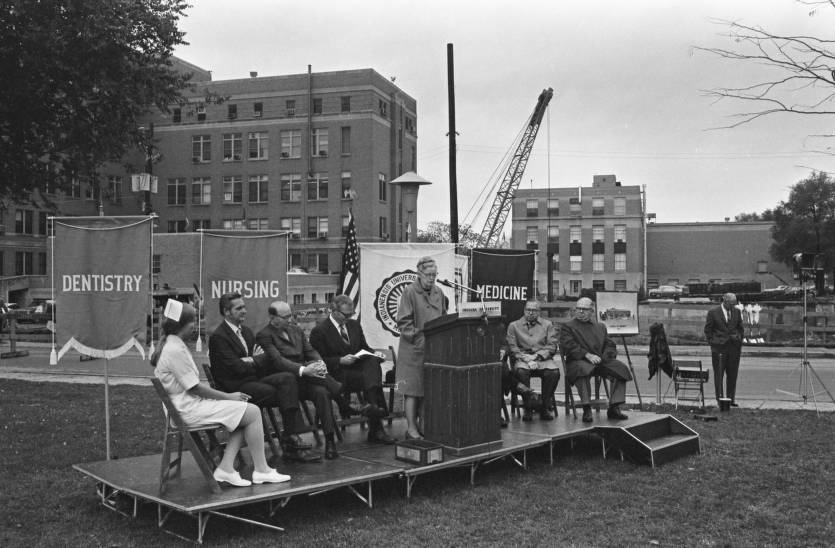
By the 1980s, IU School of Nursing was the only nursing school in the country to offer all four degrees: ASN, BSN, MSN (master of nursing science), and DNS (doctor of nursing science). Additionally, graduates of the programs helped the school stretch beyond U.S. borders by providing nursing care in Latin America, Australia, New Zealand, the United Kingdom, the Far East, the Middle East, and Africa.
While Tom Erhlich was president of the institution (1987-1994), Indiana University reorganized into a statewide multi-university administrative system, and IUSON subsequently offered a similar university-wide baccalaureate and/or associate of nursing science program on all eight campuses across the state of Indiana. With a comparable curriculum on each campus, students could more easily enroll in courses on any campus. IU School of Nursing had campuses in Indianapolis, Bloomington, Columbus, South Bend, Kokomo, Gary, New Albany, and Richmond.
Recognition in Research and Continued Growth, 1991-
Dean Angela McBride (1991–2003) served as the school’s first associate dean for research beginning in 1985. She understood that the growth of a research program was inextricably linked to the development of doctoral graduates. With the DNS in place by the 1980s, a major turning point for nursing research at IU came in 1999, when the National Institute for Nursing Research at the National Institutes of Health funded distinguished professors Joan Austin and Victoria Champion to launch the Center for Enhancing Quality of Life in Chronic Illness (CEQL), one of only nine core research centers in the country at the time. The IUSON center was dedicated to advancing knowledge related to improving quality of life for people with chronic illness.
In 2000, IUSON’s administration decided to transition the research-focused DNS degree program to the PhD. The rigor and equivalency of the DNS as a research degree was recognized in 2008, with all previous graduates awarded a PhD.
Dean Marion Broome (2004-2014) followed McBride and built upon the school’s substantial growth in research activities, strengthening the infrastructure and preparing a cadre of researchers to lead in the coming decades. Under Broome’s leadership, the IUSON began to phase out the ASN program with the adoption of an articulation agreement between Indiana University School of Nursing and . This agreement enabled nurses to move more easily from a two-year to a four-year degree.
While Broome was dean, IUSON was first awarded the designation as a Center of Excellence by the National League for Nursing in 2006. The school carries two such designations: Promoting the Pedagogical Expertise of Faculty and Advancing the Science of Nursing Education.
Two years later, in 2008, the statewide multi-university administrative system ended under then-IU president Adam Herbert. At that time, the IU School of Nursing formed a “core” school among the IUPUI, Bloomington, and Columbus campuses. The three IUSON campuses, as the core, shared accreditation for one curriculum and faculty governance.

In 2010, IUSON introduced the Doctor of Nursing Practice (DNP) degree. The DNP is the final practice degree for nurses interested in providing health systems leadership, honing their abilities to synthesize evidence-based practice and current research to develop processes and systems for better patient care.
The RN to BSN Degree Completion program, available through a consortium of all nursing campuses across the state, was also established in 2010. The program answered the call to provide a quality, convenient online RN to BSN education that met the workforce needs of Indiana. This unique program enables two-year prepared nurses to earn their BSN, even if they do not have ready access to a college campus.
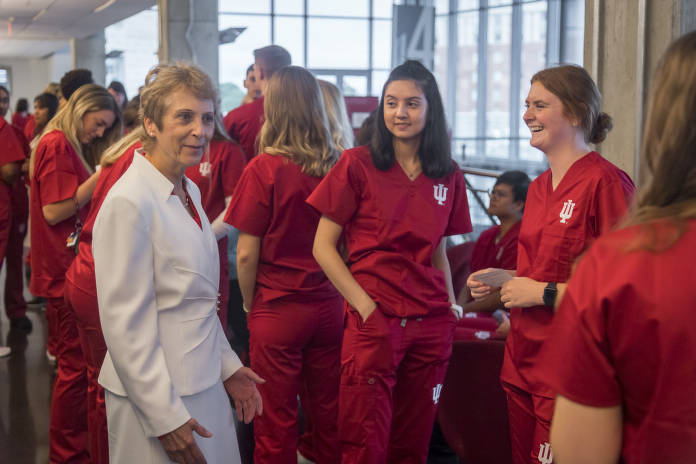
Robin Newhouse became the sixth dean of IU School of Nursing in 2015. That same year, the School of Nursing on the Columbus campus achieved independent Commission on Collegiate Nursing Education (CCNE) accreditation. The school offers the BSN and resides within the Indiana University-Purdue University Columbus Division of Health Sciences. With Columbus’ new independent status, the IUPUI and the Bloomington campuses formed the core school.
In 2016 the Indiana General Assembly reviewed a staff report, “Report on Role and Governance of IPFW [Indiana University-Purdue University Fort Wayne],” recommending a split. The change was implemented July 1, 2018, and IPFW was reorganized into two separate universities: Indiana University Fort Wayne and Purdue Fort Wayne. IU Fort Wayne officially began its academic term August 20, 2018. With this designation, the Fort Wayne campus joined IUSON as part of the core school, along with IUPUI and Bloomington. The first class of the IU School of Nursing Fort Wayne graduates received an Indiana University diploma in June 2021.

Today, the IU School of Nursing has over 22,500 alumni who work across the globe in clinical practice, research, education, and innovation. Both the master’s and DNP programs were named to the 2022 U.S. News and World Report Best Graduate Nursing Schools. Academic programs range from three options in the undergraduate program, nine tracks in the master’s program, post-master’s options, a post-masters DNP, and a PhD in clinical nursing science or health systems. IUSON supports a robust program of research focused on quality of life in chronic illness, nursing education, and cancer prevention and control.

Help improve this entry
Contribute information, offer corrections, suggest images.
You can also recommend new entries related to this topic.